| کد مقاله | کد نشریه | سال انتشار | مقاله انگلیسی | نسخه تمام متن |
|---|---|---|---|---|
| 3240915 | 1206059 | 2011 | 7 صفحه PDF | دانلود رایگان |

If distal tibia fractures cannot be treated with intramedullary nails, locking compression plates, such as the LCP Medial Distal Tibia Plate of Synthes, are used. Bridge plating with interfragmentary movement is the strategy for such osteosynthesis. Interfragmentary movement is difficult to predict. Too much movement leads to formation of more, but less stable callus; longer time until complete fracture healing has been reported. Interfragmentary movement can be controlled by the stability and flexibility of the osteosynthesis construct. We used interfragmentary screws to limit interfragmentary movement in certain cases. We noticed a tendency of faster fracture healing in patients with interfragment lag screw compared with those with sole bridge plating. We therefore retrospectively assessed our patients for time until clinical fracture healing (i.e., pain-free weight bearing and visible callus in both layers on conventional plain film radiographs) and callus formation.MethodsData (from patient chart and from regular visits) of 52 patients with fracture of the distal tibia were reviewed, of which 11 were lost to follow-up. After surgery, weight bearing was limited to 20 kg for 6 weeks and then increased in weekly intervals to the pain threshold. X-rays were taken after 3 days, 6, 12 and 24 weeks and when achieving full weight bearing. Time from surgery until ability to full weight bearing was measured and compared. Callus index was measured as quotient of callus thickness and diameter of corticalis both in a.p. and sagittal direction. Statistical evaluation was done with the Mann–Whitney U-test.ResultsA total of 41 patients could be analysed; of them, 30 patients had extra-articular fractures. Four patients had 43-B and seven patients had 43-C fractures.As many as 13/30 extra-articular fractures were treated with interfragmentary screws: In this group (n = 11, without considering one patient with plate failure and one with pseudarthrosis) time to full weight bearing was 11.38 weeks versus 14.9 weeks without screw (n = 14; without two pseudarthrosis and one deep infection) (p = 0.044). Callus index at full weight bearing was significantly lesser in patients with screw compared with those without.ConclusionThough interfragmentary screws seem to block necessary interfragmentary movement, we see callus formation as a sign of secondary fracture healing. The osteosynthesis construct with interfragmentary screw seems to be more stable and less flexible than sole bridge plating, leading to faster fracture healing. Interfragmentary screws might help to control and limit interfragmentary movement in certain cases.
Journal: Injury - Volume 42, Issue 10, October 2011, Pages 1031–1037